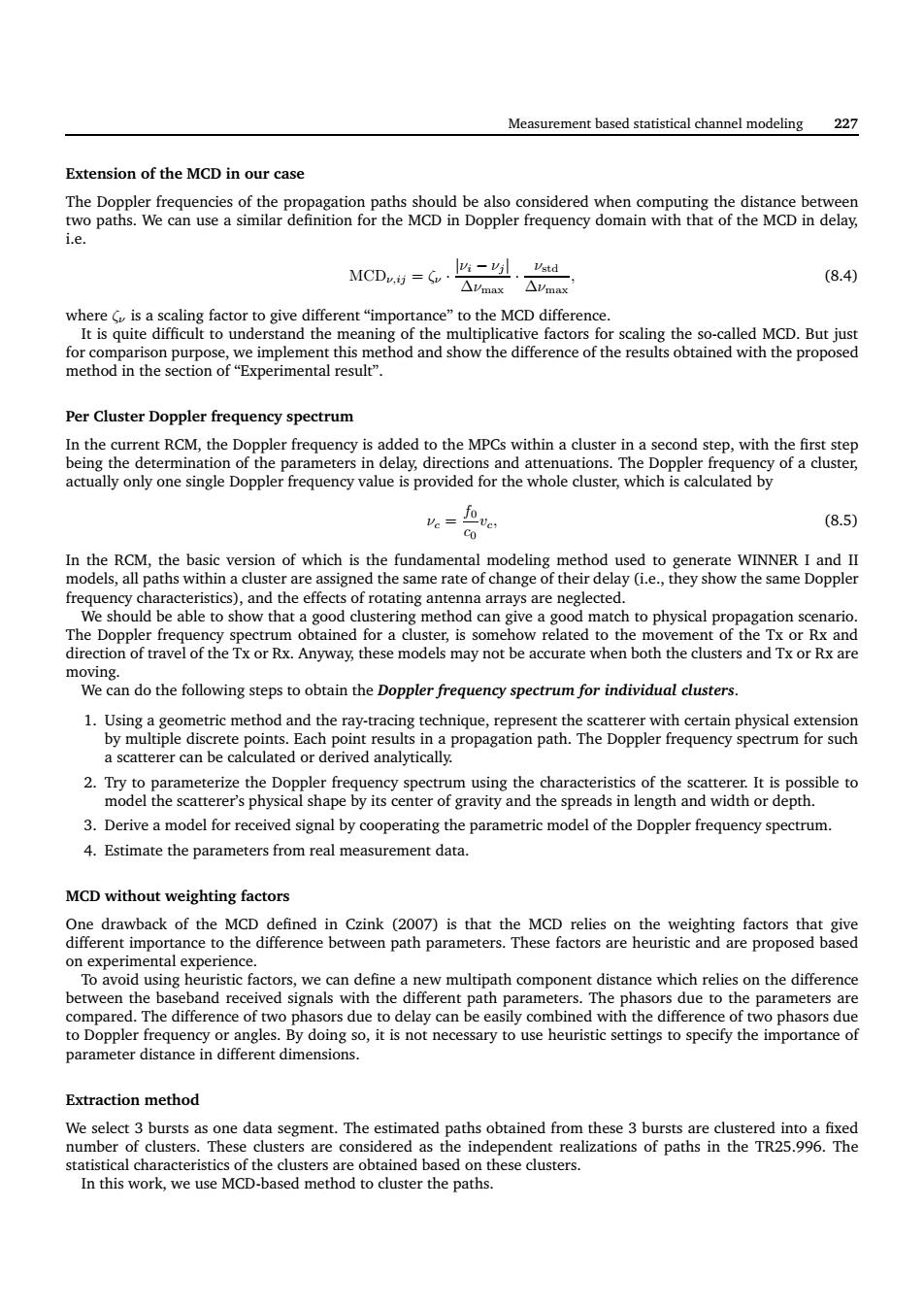正在加载图片...

Measurement based statistical channel modeling 227 Extension of the MCD in our case a@l油fc gation paths should be also considered when computing the distance between MCDw的=C.-L.a (8.4) △mnx△max C is a scaling factor nce"to the MCD differe aogaihengae&rweCpeettiRrtiodandshowthediereaceoftheresusobainedwihtheproposed Per Cluster Doppler frequency spectrum In the current RCM,the Doppler frequency is added to the MPCs within a cluster in a second step,with the first step equency alu lay,dire ter,w =色 (8.5) In the rCM.the basic version of which is the fundam WINNER I and n ract eristics),and the effects of rotating antenna arrays are neglected The Doppler freg direction of travel of the Tx or Rx.Anyway,these models may not be accurate when both the clusters and Tx or Rx are 1.Using a geometric method and the ray-tracing crith certain physical extension ssible to 3.Derive a model for received signal by cooperating the parametric model of the Doppler frequency spectrum Estimate the parameters from real measurement data MCD without weighting factors usi weca new multipath component distance which relies on the differenc between the bas band received signals with the different path parameters.The ph ors due to the parameters are e o parameter distance in different dimensions Extraction method o racteristics of the clusters are obta ained based on these clusters. In this work,we use MCD-based method to cluster the pathsMeasurement based statistical channel modeling 227 Extension of the MCD in our case The Doppler frequencies of the propagation paths should be also considered when computing the distance between two paths. We can use a similar definition for the MCD in Doppler frequency domain with that of the MCD in delay, i.e. MCDν,ij = ζν · |νi − νj | ∆νmax · νstd ∆νmax , (8.4) where ζν is a scaling factor to give different “importance” to the MCD difference. It is quite difficult to understand the meaning of the multiplicative factors for scaling the so-called MCD. But just for comparison purpose, we implement this method and show the difference of the results obtained with the proposed method in the section of “Experimental result”. Per Cluster Doppler frequency spectrum In the current RCM, the Doppler frequency is added to the MPCs within a cluster in a second step, with the first step being the determination of the parameters in delay, directions and attenuations. The Doppler frequency of a cluster, actually only one single Doppler frequency value is provided for the whole cluster, which is calculated by νc = f0 c0 vc, (8.5) In the RCM, the basic version of which is the fundamental modeling method used to generate WINNER I and II models, all paths within a cluster are assigned the same rate of change of their delay (i.e., they show the same Doppler frequency characteristics), and the effects of rotating antenna arrays are neglected. We should be able to show that a good clustering method can give a good match to physical propagation scenario. The Doppler frequency spectrum obtained for a cluster, is somehow related to the movement of the Tx or Rx and direction of travel of the Tx or Rx. Anyway, these models may not be accurate when both the clusters and Tx or Rx are moving. We can do the following steps to obtain the Doppler frequency spectrum for individual clusters. 1. Using a geometric method and the ray-tracing technique, represent the scatterer with certain physical extension by multiple discrete points. Each point results in a propagation path. The Doppler frequency spectrum for such a scatterer can be calculated or derived analytically. 2. Try to parameterize the Doppler frequency spectrum using the characteristics of the scatterer. It is possible to model the scatterer’s physical shape by its center of gravity and the spreads in length and width or depth. 3. Derive a model for received signal by cooperating the parametric model of the Doppler frequency spectrum. 4. Estimate the parameters from real measurement data. MCD without weighting factors One drawback of the MCD defined in Czink (2007) is that the MCD relies on the weighting factors that give different importance to the difference between path parameters. These factors are heuristic and are proposed based on experimental experience. To avoid using heuristic factors, we can define a new multipath component distance which relies on the difference between the baseband received signals with the different path parameters. The phasors due to the parameters are compared. The difference of two phasors due to delay can be easily combined with the difference of two phasors due to Doppler frequency or angles. By doing so, it is not necessary to use heuristic settings to specify the importance of parameter distance in different dimensions. Extraction method We select 3 bursts as one data segment. The estimated paths obtained from these 3 bursts are clustered into a fixed number of clusters. These clusters are considered as the independent realizations of paths in the TR25.996. The statistical characteristics of the clusters are obtained based on these clusters. In this work, we use MCD-based method to cluster the paths